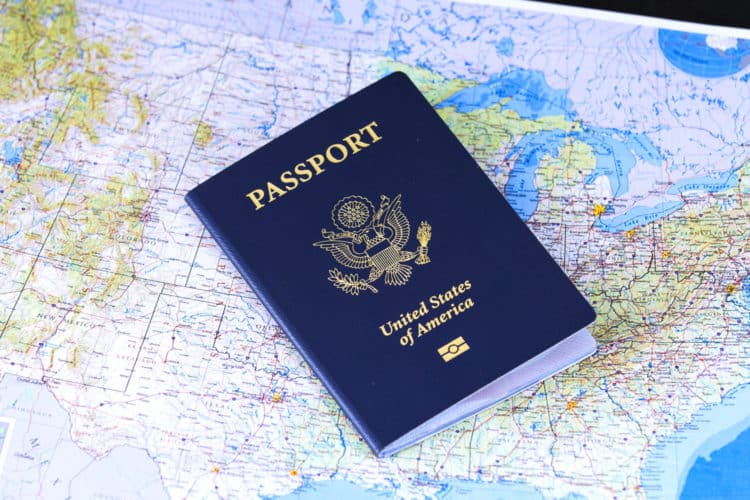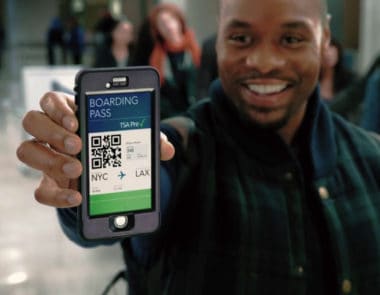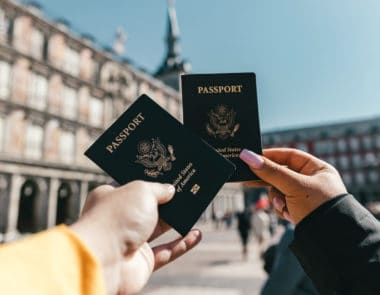Flying with a Lap Child Guide — How to Manage Flying with an Infant on Your Lap
If you’re a new parent, you might’ve not traveled — or at least flown — with your young child before. And we’ve all seen it. A harried-looking mom or dad scrambles onto your flight holding all sorts of baby gear. They plop their diaper bag in the overhead compartment and settle in for the flight with a baby on their lap. It’s just the norm, right? So, you, too, should be able to just waltz onto your next flight with your infant and be good to go … Right?
But hold on there a second. You might be eager to get on your next flight, but you don’t want to break the rules or end up unable to board your flight entirely. There are requirements for flying with a lap child and those requirements differ according to the type of flight you’re on, as well as your airline.
To make your next trip with an infant or toddler easier, here’s everything you need to know about flying with a lap child.
Keep in mind, all of the below standard requirements may differ according to your airline. So, always, always check with your airline before arriving at the airport. You don’t want to end up stranded, all because one airline has an odd or differing policy that you weren’t aware of.
The Vacationer Tip
Once you’ve learned the requirements for your lap child, check out our guide on How to Find and Book Cheap Flights. Also, don’t forget to leverage your credit card to save even more money when you travel. If you do not have a travel-rewards credit card, our highest recommendations are the Chase Sapphire Preferred® Card, the Capital One Venture X Rewards Credit Card, and the Citi Premier® Card. If you would like to see other offers, Click to See All of Our Recommended Travel Credit Cards.
Table of Contents
Rules for Flying with a Lap Child: Domestic vs. International Flights
Across the board, lap children must be under 2 years of age. The only differences between flying with a lap child on a domestic versus international flight are the documentation needed and, occasionally, cost. Sometimes, an international flight will require taxes and fees for your lap child. These fees are typically around 10% of the adult airfare.
Rules for Flying with a Lap Child: Needed Documentation
As mentioned, the documentation required for your lap child will differ according to whether you’re flying domestically or internationally.
Even if your child is under 2, they’ll still need a passport for flying on international flights. That rule applies to every single international traveler, regardless of age. It’s also not a bad idea to bring along their birth certificate. This will be valuable in the event an airline employee tries to question your child’s age. If you can’t prove your child is under 2, you may be forced to purchase a separate seat for your child.
When it comes to domestic flights, things are a little bit trickier. If you have a newborn, you’ll want to talk to your airline. Some airlines require that you get a letter from your pediatrician, approving your child for a flight. Some won’t allow children under 7 days old to fly at all, regardless of documentation.
If your child is not a newborn, but a month or older, then you’ll want to bring along your child’s birth certificate. This is, again, just to prove their age when/if needed. You can bring a passport if your child has one, but it’s not necessary.
If you’re traveling with your child alone, without the child’s other parent, your documentation needs may differ there as well.
Check out our full What ID and Documents Does My Child Need To Fly? guide.
Rules for Flying with a Lap Child: Ticket Requirements
When flying domestically, you’ll need to have your lap child listed on your reservation, but you won’t need to buy them a ticket. However, when flying internationally, you’ll need to reserve a ticket for your lap child. If you don’t see an option to do this online, call your airline’s reservation number.
Rules for Flying with a Lap Child by Airline
So what are the rules for your airline of choice? Here’s the skinny from some of America’s top airlines.
United Airlines
United Airlines allows children under the age of 2 to travel as lap children with either a parent or other passenger 15 years old or older. Only one lap child per adult is permitted. On international flights, children under 2 are required to have a purchased ticket, with infant fares and taxes, even if they’re traveling as a lap child.
On some flights, passengers with lap children may not be allowed to sit in certain areas, to ensure there are enough oxygen masks for all passengers. However, this is only the case on certain aircraft.
Get the full breakdown of United Airlines’ lap child policy, here.
American Airlines
According to American Airlines, if you’re traveling with an infant less than seven days old, your physician will be required to fill out a passenger medical form before your flight. A special assistance coordinator will send the form directly to your physician. Infants must be accompanied by someone 16 years or older, or by their parent, all flying in the same cabin.
Children under 2 are allowed to sit in a parent’s lap (or whoever is traveling with them that’s older than 16). The lap child must be on your reservation and you can add them to your reservation online, for a domestic flight, or by calling reservations for an international flight. You still may have to pay taxes and a percentage of an adult fare, even for a lap child, depending on the circumstances. Also, if your child turns 2 during the duration of your trip, they’ll be required to purchase a seat for the time of the trip that they’re 2 years old.
Get the full breakdown of American Airlines’ lap child policy, here.
Delta Air Lines
On Delta, children under 2 can travel as a lap child for free within the United States or at a reduced fare on international flights. Only one lap child per adult is allowed. Lap children are only permitted when they’re traveling with a parent, legal guardian, or another adult over 18 years of age. Regardless of if you’re traveling domestically or internationally, you’ll have to add the child to your ticket. For international flights, you’ll need to notify Delta Reservations directly to do so.
Get the full breakdown of Delta’s lap child policy, here.
Frontier Airlines
Frontier likewise allows for children from 7 days old to 2 years of age to fly as lap children. Additionally, Frontier allows for adults traveling with a lap child to carry a second personal item for free. Only one lap child per adult is permitted. Lap children may not sit in any seat that has an airbag seatbelt installed, which includes the first row on most aircraft. Two adults with two lap children cannot sit on the same side of a row because there are only four oxygen masks per every three seats on Frontier’s aircraft.
Get the full breakdown of Frontier’s lap child policy, here.
JetBlue
JetBlue accepts lap children from age 3 days to 2 years, at no charge. You can add a lap child to your domestic reservation during booking online, or call JetBlue to add them to an existing reservation. JetBlue only requires lap children infant fees if you’re departing from an international destination. If a child turns 2 between their outbound and return flight, they will need a purchased seat for the return flight. JetBlue requires all lap children to show proof of age. You can use a passport, birth certificate, or immunization record for this. Children between 3 days and 14 days old additionally require a doctor approval letter.
JetBlue only allows one lap infant per passenger ages 14 and up. JetBlue does not permit lap children in emergency exit rows. It also only allows a limited number of lap children on long, over-water flights.
Get the full breakdown of JetBlue’s lap child policy, here.
Spirit Airlines
Spirit allows you to bring along one lap child per adult in your party, 15 years or older. Lap children must be between the ages of 7 days and 23 months. The airline does not allow lap children in emergency exit rows or the rows in front or behind the emergency exit rows. It also does not allow lap children in seats with inflatable seat belts. You may have to pay lap child taxes and fees, depending on your destination. Adding a lap child to your reservation is an option available when booking.
Get the full breakdown of Spirit Airlines’ lap child policy, here.
5 Tips for Flying with a Lap Child
Okay. Do you have all the logistics and technicalities for flying with your child down? Good. Here are a few quick tips to make your time once you’re boarded, more enjoyable.
1. Book your flight to compliment your child’s sleep schedule.
No one likes the parent with the crying baby. While it sometimes can’t be helped, do your best to keep your baby quiet during your flight. This means booking a flight that will compliment your child’s sleep schedule. That’s not necessarily when your child will be sleeping, but rather when they’re least fussy.
2. Bring something for the pressure.
As an adult, you know to chew gum or puff out your cheeks to help relieve ear pain from the changing air pressure while flying. But what about your baby? To help them cope, pop in that bottle or pacifier during take-off and landing. The sucking motion can help alleviate the pain and pressure.
3. Consider adding some baby-carrying tools to your arsenal.
Sure, carrying your baby during your flight helps to save a little cash, but you likely don’t want to hold your baby the entire flight. To give your arms a break, consider purchasing a baby sling. It’ll keep your baby safe and comfy against your chest while leaving you free to move about.
You can also make an effort to book a flight and seat that will come with a bassinet. This will give you a spot to lay your baby down between take-off and landing. Bassinets are typically available if you’re flying on a 777-200, 777-300, or 787 aircraft. Bassinets are available on a first-come, first-served basis, and aren’t available in certain classes.
4. Pick the right seat.
If you want more privacy and don’t expect to get up and down a lot during your flight, pick a window seat. If you do think you might end up getting up and down, go with the aisle seat so that you won’t have to juggle your baby while also crawling over your seatmates’ laps. Avoid seats near the bathroom if you don’t want to deal with lots of people walking past (and possibly disturbing your baby’s sleep).
5. Don’t let rude passengers deter you.
Some air travelers are just plain mean. These folks can be exceptionally rude to flying parents. Don’t let their comments or side-eye glances get you down. For every rude passenger, there’s another fellow parent who’s been in your exact shoes.
A Disclaimer: Is Flying with a Lap Child Safe?
It’s necessary to include a quick disclaimer before you head out on your next flight, lap child in tow. While flying with a lap child is pretty acceptable and not frowned upon, the Federal Aviation Administration does not advise it. The FAA, instead, advises that you purchase a child safety restraint system, similar to a car seat. The FAA does not approve all car seats for use on airplanes, though. Therefore, you will want to check that your current child safety restraint system is suitable for use before flying. You can find the FAA’s full recommendations for child safety restraint systems for flying here.
Unfortunately, following the FAA’s recommendations does mean that you’ll need to buy a seat for your child, regardless of their age. The FAA does recommend, however, asking your airline for a discount if you opt to use a child safety restraint system versus holding your child in your lap.
FAQ
On domestic flights, no. On international flights, fees and taxes may apply (generally approximately 10% of an adult fare).
Most airlines require lap children to be between 7 days old and 2 years old. If your child turns 2 between your outgoing and return flight, the airline will charge you the full seat cost for your return flight.
Airlines usually allow parents and those ages 15 and up to fly with a lap child, but this is dependent on the airline.
You’ll need a passport if flying internationally. If flying domestically, you’ll only need proof of age, such as a birth certificate or vaccination record.
Get The Vacationer Newsletter
Get highlights of the most important news delivered to your email inbox






